- What is Metal Engraving?
- How Does Laser Engraving Work?
- What Metals Can Be Laser Engraved?
- Standard Methods used for Metal Engraving
- What’s The Difference between Metal Laser Engraving Vs. Laser Marking
- What’s the difference between Laser Engraving vs. Laser Etching?
- Tips for Laser Engraving On Metal
- Conclusion
What is Metal Engraving? The Complete Guide of Laser Engraving On Metal
In the vast and intricate world of metalwork, the metal engraving technique stands out as a testament to human creativity and technological advancement. As a CNC machining and metal fabrication professional, I’ve witnessed firsthand the evolution of metal engraving techniques from traditional manual methods to the high-tech, laser-driven processes we rely on today.
Metal engraving, particularly laser engraving, is an art form as much as a technical process. It involves removing parts of the metal surface to create a permanent mark, design, or text that can range from purely functional to elaborate artistically. The precision and versatility of laser engraving make it an indispensable tool for industries requiring high-quality and durable markings on their products.
Now, if you’re picturing yourself unleashing your creativity on metal or simply looking to understand how your business can benefit from this technology, you’ve come to the right place. Let’s dive deeper into the world of laser engraving on metal and explore its potential together.
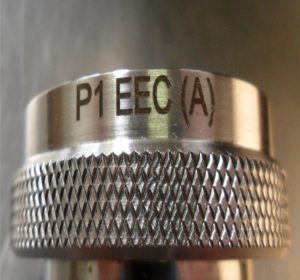
What is Metal Engraving?
Metal engraving is an art and manufacturing process that involves incising a design into a metal surface. At its heart, it’s a form of expression and communication used throughout history to tell stories, commemorate events, and mark the passage of time. But it’s also a critical tool in modern manufacturing, providing a way to customize, brand, and add functional details to metal parts and products.
Traditionally, engraving was done by hand, with skilled artisans using burins or gravers to cut designs into metal. This method required artistic talent, a steady hand, and a deep understanding of the engraved material.
Today, while traditional hand engraving still holds a place in the arts, laser engraving has become the standard in many industrial applications. Laser engraving offers unmatched precision and speed, allowing for intricate designs that would be impossible or prohibitively time-consuming by hand.
What makes metal engraving genuinely fascinating is its versatility. From the delicate patterns on a piece of jewelry to the serial numbers on aerospace components, engraving serves aesthetic and functional purposes. It’s a bridge between the old and the new, combining ancient techniques with modern technology to create something that is both beautiful and practical.
How Does Laser Engraving Work?
At its core, laser engraving employs a powerful laser beam directed by a computer to remove material from the surface of a metal. It’s a subtractive manufacturing technique, which means it takes away material rather than adds it. Here’s how it unfolds:
- Preparation: Before anything else, the design is meticulously crafted and programmed into computer-aided design (CAD) software. This digital blueprint will guide the laser’s path, ensuring every curve and line is precisely where it should be.
- Calibration: The metal piece is secured in place, and the laser engraving machine is calibrated for the specific type of metal used. This involves adjusting the laser’s power and speed and focusing on matching the material’s properties and the desired depth of the engraving.
- Engraving Process: With everything set, the engraving begins. The laser beam moves across the metal’s surface, following the design’s contours. As it does, it vaporizes the material in its path, creating the engraving. The intensity of the laser can be adjusted to achieve different effects, from shallow, delicate lines to deeper, more pronounced grooves.
- Cooling and Cleaning: After the engraving is complete, the metal piece often needs to cool down. Any residues from the engraving process, such as dust or vaporized material, are cleaned off, revealing the finished design.
- Finishing Touches: Depending on the project, additional finishes, such as polishing or coating, may be applied to the engraved piece to enhance its appearance and protect the engraving.
The beauty of laser engraving lies in its precision and versatility. It can produce intricate designs that manual methods could never achieve, from delicate patterns that resemble lace to crisp text and logos. Furthermore, laser engraving is not limited by the complexity of the design; if you can imagine it and draw it, chances are, you can engrave it.
The applications for laser engraving are as diverse as the designs it can create. Laser engraving has become indispensable in many sectors, from personalized jewelry and bespoke gifts to industrial parts marked with serial numbers or barcodes. It balances aesthetic appeal and functionality, providing a durable and permanent solution for keeping metal.
What Metals Can Be Laser Engraved?
Aluminum
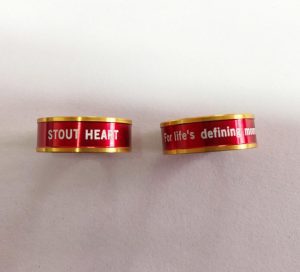
Ah, aluminum, the versatile and lightweight friend of manufacturers and artists alike. It engraves beautifully under a laser, creating a stark, white mark against its typically silver surface. Aluminum is particularly friendly for laser engraving, especially when anodized or treated, as it provides a high-contrast finish. Ideal for everything from industrial tags to bespoke artwork, it’s as versatile as it is easy to work with.
Stainless Steel
Stainless steel is like the stoic warrior of metals – resilient and reliable. Engraving on stainless steel requires a more potent laser setting due to its hardness and heat resistance, but the results are profoundly durable and corrosion-resistant.
This makes it perfect for medical tools, kitchenware, and outdoor applications where longevity is key. Using a marking compound can enhance the contrast and visibility of the engraving on stainless steel, making it durable and striking.
Brass and Copper
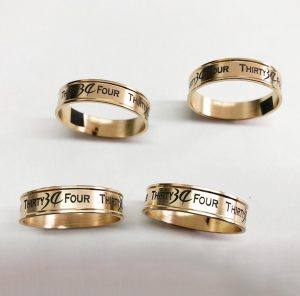
These two metals are the extroverts in the metal family, bright and eager to show off their engravings with flair. Brass and copper engrave with a unique quality, often resulting in a subtle, vintage look that’s highly sought after for plaques, awards, and decorative items. However, they do require a bit of finesse, as their thermal conductivity can lead to variations in the engraving quality if not correctly managed.
Titanium
Titanium is the high-tech, aerospace-grade option that boasts both lightweight and strength. Engraving on titanium produces sharp, detailed marks, making it ideal for industrial applications and jewelry. Its resistance to corrosion and high melting point make it challenging yet rewarding to work with, offering an elegant and enduring unique finish.
Gold, Silver, and Platinum
The precious metals are valuable and wonderfully malleable under a laser’s touch. Engraving on these metals is often reserved for the most personalized and high-end items, like jewelry and luxury goods. They allow for highly detailed and delicate designs, though using a lower power setting is essential to avoid unnecessary material loss or damage to these softer metals.
Tips for Laser Engraving Different Metals
- Preparation is Key: Always clean the metal surface before engraving to remove any oils or residues affecting the engraving quality.
- Know Your Material: Adjust the laser’s power, speed, and frequency settings according to the specific metal you work with. Each metal has its own ‘sweet spot’ for these settings.
- Test Runs: Whenever possible, perform a test run on a scrap piece of the same material to ensure the settings produce the desired outcome.
- Cooling Matters: For metals with high thermal conductivity, like brass and copper, applying a cooling agent or using intermittent engraving techniques can help maintain quality.
Standard Methods used for Metal Engraving
Hand Engraving
The traditional art of hand engraving is where it all began. This method involves using manual tools, such as burins or gravers, to cut designs directly into the metal. It’s a skill that requires a steady hand, a keen eye, and an immense amount of patience.
The results, however, are undeniably unique and carry a personal touch that machines can’t replicate. Hand engraving is favored for custom jewelry, artistic pieces, and historical reproductions where the human touch is part of the allure.
Mechanical Engraving
A step towards modernization, mechanical engraving uses machine-operated cutting tools to carve out designs on metal surfaces. This method is more consistent and faster than hand engraving and allows for reproducibility.
Mechanical engraving machines can range from simple, manually operated models to complex CNC (Computer Numerical Control) systems that offer precision and automation. It’s a go-to for trophies, plaques, and commercial signage where uniformity and efficiency are essential.
Electrochemical Etching
Electrochemical etching, also known as chemical etching, employs a controlled chemical reaction to remove metal and create an engraved effect. This process involves applying a protective mask to the metal surface, leaving only the areas to be engraved exposed to the chemical. It’s beneficial for intricate designs on thin metal sheets and is widely used in the electronics industry for circuit boards and precision components.
Laser Engraving
As discussed, laser engraving stands out for its precision, versatility, and speed. It uses a high-powered laser beam to vaporize material, creating deep, durable marks. The process is non-contact, meaning there’s no physical wear on the tools, and it can be precisely controlled with CNC technology. This makes laser engraving an excellent choice for serial numbers, barcodes, and detailed artwork on virtually any metal surface.
Choosing the Right Method
- For Personalization: Hand engraving remains unmatched.
- For Uniformity and Volume: Mechanical engraving is efficient.
- For Precision on Thin Materials: Electrochemical etching is ideal.
- For Versatility and Detail: Laser engraving is the superior choice.
What’s The Difference between Metal Laser Engraving Vs. Laser Marking
Laser Engraving
Laser engraving uses a laser beam to physically remove the material’s surface, creating a cavity that reveals an image at eye level. The laser creates high heat during this process, causing the material to vaporize. It’s a subtractive manufacturing method that results in depth, which can be felt if you run your hand across the surface of the engraved metal.
- Depth: The most significant feature of laser engraving is its depth, typically reaching up to 0.020″ in metals but can go as deep as 0.125″ in materials like graphite. This depth provides durability, making laser engraving ideal for items that undergo heavy wear and tear, such as tools, automotive parts, and outdoor equipment.
- Versatility: Laser engraving works on almost any metal hardness and can create complex, precise designs that are visually appealing and functional.
- Durability: The engraved marks can withstand environmental challenges like heat, moisture, and contact with chemicals, making them permanent and ideal for critical components in aerospace, automotive, and industrial applications.
Laser Marking
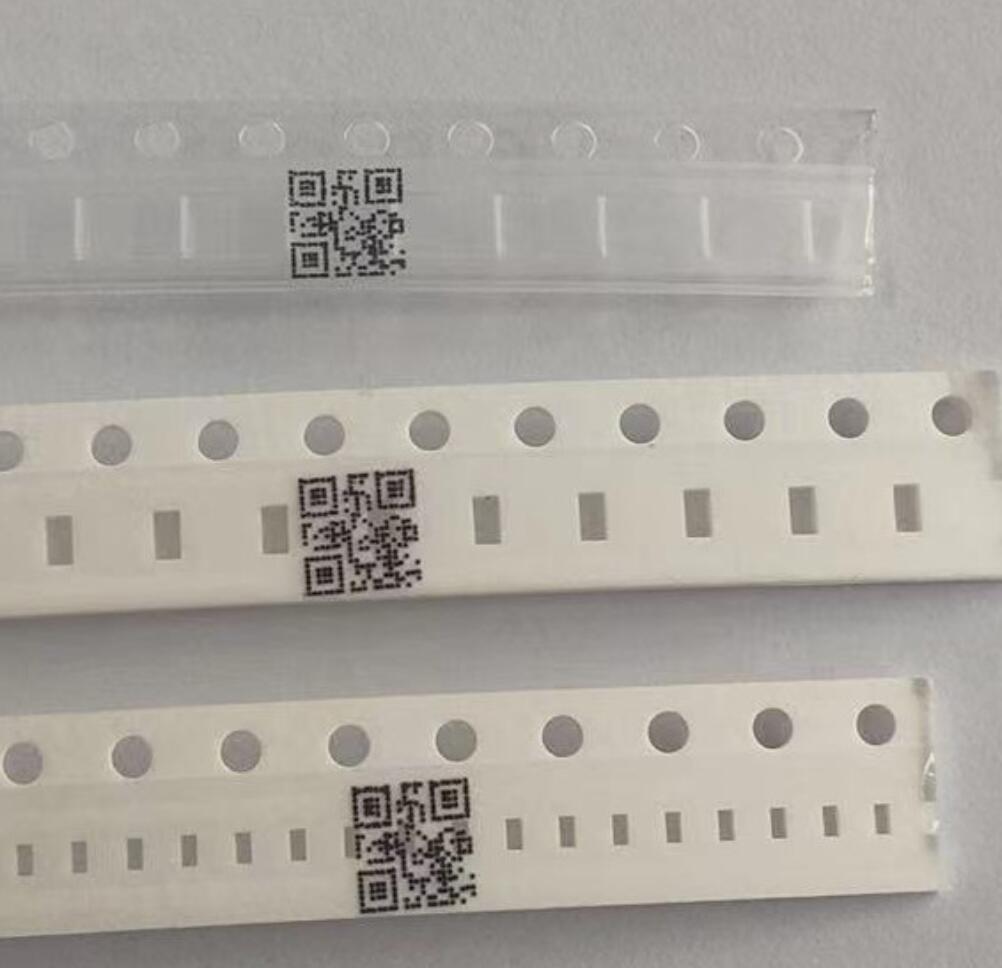
Laser marking, however, involves altering the metal’s surface rather than removing material. This process, often called coloration or annealing, changes the metal’s color by affecting only its surface, creating high-contrast markings without cutting into the material. Laser marking is particularly popular for barcodes, QR codes, logos, and other identification marks on industrial products.
- Surface Alteration: Unlike engraving, laser marking does not create depth. It induces a chemical reaction in the material, leading to a color change on the metal surface, offering a mark that is essentially surface-level.
- Speed and Efficiency: Marking is generally faster than engraving because it doesn’t remove material. This speed makes it suitable for high-volume production lines.
- Material Integrity: Since the laser marking process doesn’t compromise the material’s surface integrity, it’s ideal for safety-critical parts and delicate components where maintaining the original strength and structure of the material is crucial.
Choosing Between Laser Engraving and Laser Marking
The decision between laser engraving and marking boils down to the application’s requirements:
- Durability Needs: Choose engraving for applications requiring high durability.
- Material Conservation: Opting for marking when preserving the material’s integrity is vital.
- Aesthetic Preferences: Engraving offers depth and texture while marking provides a smooth, high-contrast finish.
- Production Efficiency: Marking’s speed makes it suitable for high-volume projects.
What’s the difference between Laser Engraving vs. Laser Etching?
Laser Engraving
As previously discussed, laser engraving involves the removal of material from the surface of a metal to create a visible mark or design. The laser beam in engraving is intense enough to cause the metal to vaporize, resulting in a cavity in the surface that is noticeable both visually and to the touch. This method is prized for its depth, precision, and durability.
- Applications: Laser engraving is commonly used for serial numbers, logos, and intricate designs on various metal surfaces. It’s beneficial in industries where part identification and durability are critical, such as automotive, aerospace, and industrial machinery.
- Benefits: The depth achieved through engraving ensures that the markings withstand physical wear and environmental conditions, making it ideal for items that face harsh use or exposure.
Laser Etching
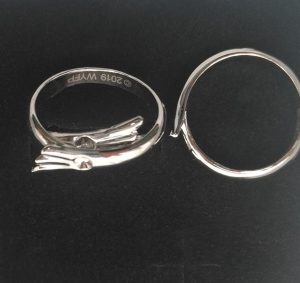
Laser etching is a subset of laser engraving, but instead of removing material, it melts the surface of the metal, causing it to expand and create a raised mark. The etching process uses a lower-powered beam than engraving, making it faster and affecting only the very top layer of the material. This method is less about depth and more about creating a high-contrast mark without significantly altering the surface structure of the metal.
- Applications: Laser etching is often used for labeling and branding parts, equipment safety warnings, and decorative designs of consumer goods. Its ability to quickly and efficiently mark metals makes it suitable for industrial and artistic applications.
- Benefits: The primary advantage of laser etching is its speed and the fact that it can mark fragile materials without compromising their integrity. It can also produce a highly detailed, high-contrast image, making it ideal for QR codes and intricate logos.
Choosing Between Laser Engraving and Laser Etching
The choice between laser engraving and etching boils down to the project’s specific needs:
- Depth and Durability: If the project requires markings that must endure heavy wear or harsh conditions, laser engraving is the better choice.
- Speed and Efficiency: Laser etching may be more appropriate for projects where speed is of the essence, and the material is relatively thin.
- Material Compatibility: While both techniques can be used on a wide range of metals, the specific material and properties might make one method more suitable.
- Aesthetic Requirements: The desired aesthetic outcome also influences the choice. Engraving offers a more textured, three-dimensional appearance, whereas etching provides a smoother, high-contrast finish.
Tips for Laser Engraving On Metal
Understand Your Material
Reflectivity, thermal conductivity, and surface hardness influence each metal’s personality. Before you start, get to know your material. Test engraving on a sample piece can reveal how the metal reacts to the laser, helping you adjust settings for optimal results.
Optimize Your Laser Settings
The key to a successful engraving is finding the sweet spot with your laser’s speed, power, and frequency settings. Too much power and you might burn the metal; too little and the engraving won’t be apparent. Adjust these parameters based on the metal type and the desired depth and clarity of the engraving.
Clean the Surface
A clean surface is critical for a crisp, precise engraving. Any dirt, oils, or oxides on the metal can interfere with the laser’s ability to create an accurate mark. Use an appropriate cleaning solution to ensure the metal surface is spotless before you begin.
Use the Right Focus
The laser’s focus is crucial for achieving a sharp engraving. The engraving appears blurry or uneven if the laser needs to be adequately focused on the clear surface. Take the time to adjust the focus according to the manufacturer’s instructions for your specific laser engraver.
Consider Using a Marking Compound
For metals that are difficult to engrave directly, such as specific grades of stainless steel or aluminum, applying a marking compound can enhance the contrast and quality of the engraving. These compounds are designed to react with the laser, creating a dark, permanent mark that stands out against the metal background.
Control the Heat
Excessive heat can warp the metal or cause uneven engraving. To manage heat buildup, consider using multiple passes at lower power settings instead of one high-power pass. Some metals benefit from cooling during engraving, either with air assistance or by placing the metal on a heat-absorbing surface.
Practice Makes Perfect
Like any skill, mastering laser engraving on metal takes practice. Experiment with different settings, techniques, and types of metal to develop a feel for what works best. Keep detailed notes on your experiments to create a reference for future projects.
Safety First
Lastly, always remember the importance of safety. Laser engravers can be dangerous if not used correctly. Always wear appropriate eye protection, operate the engraver in a well-ventilated area, and follow the manufacturer’s safety guidelines.
Conclusion
Whether you’re an industry veteran or new to metal fabrication, I encourage you to explore the potential of laser engraving. Experiment with different metals, refine your technique and don’t be afraid to push the limits of your creativity. The future of metalwork is bright, and laser engraving is a shining beacon in precision manufacturing and design.

